Michael Macey is a post-doctoral researcher with the AstrobiologyOU research group at The Open University. His research explores the microbial communities that live in some of the most extreme environments on Earth; environments that Michael and his colleagues believe closely resemble early environments on Mars. Using microorganisms isolated from these extreme environments, he performs laboratory-based experiments using conditions that simulate early Mars to investigate how life could have grown on Mars and the bio-signatures it might have left behind.
Can you describe the journey that brought you to this area of research?
My introduction to microbial ecology came when I spent a year at the University of Aarhus while I was studying for my first degree, in biology, at the University of York. After I graduated, I moved on to a PhD studying carbon cycling in soil environments, specifically studying microbes that consume methanol.
The post-PhD move to AstrobiologyOU at the Open University might seem a bit odd but the methods I am using to study microbes in extreme environments are the methods I learned during my PhD; I’m using the same methods to answer a different set of questions.
My research is now split between studying microbes that live in environments on Earth which we believe closely resemble the current environment of Mars and performing experiments to grow microbes in simulated Martian conditions.
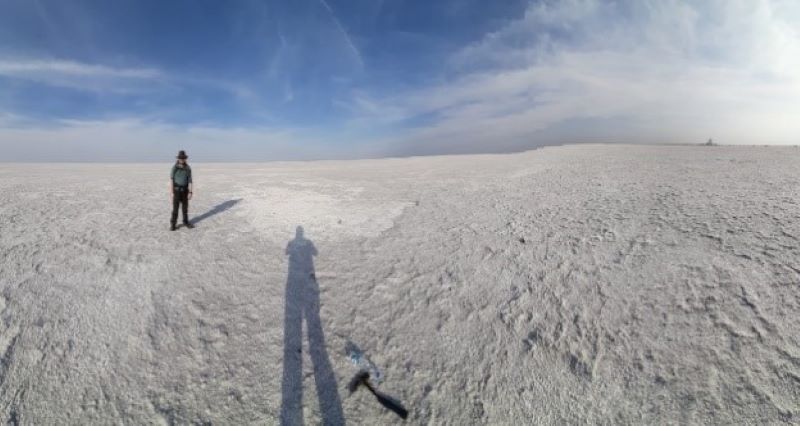 A region of the Great Rann of Kachchh. During the dry seasons the salt flats can be incredibly extensive, as evidenced by the salts expanding past the horizon.
A region of the Great Rann of Kachchh. During the dry seasons the salt flats can be incredibly extensive, as evidenced by the salts expanding past the horizon.
You study microbes living in environments that you believe have strong similarities with conditions on Mars. But how do we know what Mars is like?
Some of the data about conditions on Mars comes from the missions – the landers and rovers that have explored Mars, taken samples and analysed them. From these analyses we are starting to get a better idea of variation from place to place on Mars. We know for example that some regions of Mars are very rich in sulphur and that perchlorates are present on its surface at very high concentrations; indeed at levels that we don’t see on Earth.
From missions that have put spacecraft into orbit around Mars we know that it has a very thin atmosphere, with a very low percentage of nitrogen compared to the Earth’s atmosphere. All living things need nitrogen, so does this mean Mars is uninhabitable? In fact, research done by Dr Jennifer Stern and her colleagues in 2015 showed that a type of rock found on the surface of Mars, called mudstones, contained levels of nitrogen compounds – nitrates – on a par with concentrations we see on Earth. The other elements that are considered essential for life (carbon, phosphorus, sulfur, oxygen and hydrogen) have also been detected on Mars, so perhaps it was once habitable.
But the surface of Mars definitely isn’t habitable now! Mars’s surface can’t sustain liquid water and its thin atmosphere means high levels of ultra-violet (UV) radiation reach the surface. This UV radiation reacts with the perchlorates present on Mars’s surface to create chemicals that kill bacteria. Research done by the UK Centre for Astrobiology (Wadsworth and Cockell, 2017) showed these chemicals can even kill very hardy spore-forming bacteria that can survive most conditions on Earth.
Even though Mars is mostly dry now, the Martian landscape has features that on Earth are associated with flowing water, meaning there was once water on Mars’s surface. We know there are salts on the surface of Mars now, so this means the last waters on Mars must have been saline. But early in Mars’s history they might not have been extremely saline; it’s possible conditions in Mars’s waters might have been quite clement.
One of the great things about working in AstrobiologyOU is that I work with colleagues whose research skills are in different areas to mine, and we can add them together. Some of my colleagues run sophisticated computer models that can take what we know about conditions on Mars now and work back to how Mars might have been billions of years ago. For example, we know certain minerals were present in the waters of Mars; looking at the way the water interacts with those minerals, we can look back in time and model the chemistry of Mars’s water in the distant past.
What’s the reason for studying life in sites on Earth that are analogous with conditions on Mars?
This is a question I think about a lot. We know that some areas of Mars have a higher probability of having sustained life in the past. Studying analogue sites on Earth is valuable because it helps us gather information that we can use to develop hypotheses about the habitability of Martian environments.
Life has all sorts of survival strategies; on Earth we have seen organisms that survive being entombed in salt or organisms that survive by forming spores. Understanding how these strategies are preserved over time is valuable information; evidence from Earth has increased our understanding of the sometimes extreme environments where life can exist.
We can also use evidence from Earth analogues to develop our ideas about biosignatures. Biosignatures are the signs, such as particular chemicals or molecules, that life leaves behind it. Finding a biosignature would be good evidence that life once existed in that place. But we don’t always know what a biosignature looks like. For example, with my colleagues I’ve been working on characterising the microbial communities living in springs in the Canadian High Arctic (Macey et al., 2020) – more on that later. We identified a group of microorganisms – sulfur-oxidising bacteria – that live in the springs. These bacteria produce the energy they need to survive by oxidising sulfur. This group hadn’t been considered as organisms that could be viable on Mars but knowing they are capable of surviving under conditions that are very similar to Mars’s means we can ask questions about what might have happened to the chemistry of Mars if microbes like these had once lived there, giving us a potential biosignature.
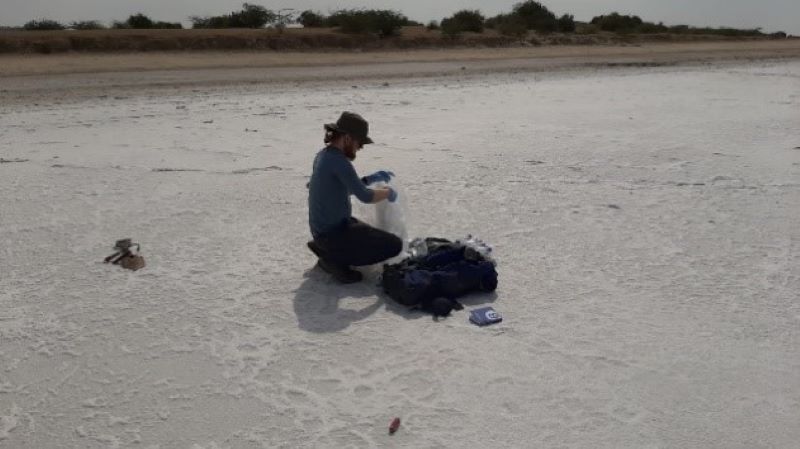 Sampling preparation at the edge of part of the Great Rann of Kachchh. We took a specific set of samples from each site we visited to allow us to characterise it as extensively as possible
Sampling preparation at the edge of part of the Great Rann of Kachchh. We took a specific set of samples from each site we visited to allow us to characterise it as extensively as possible
How do you identify places on Earth that are good candidates to be analogues for Mars?
‘Analogue’ is a broad term. It’s important to look at exactly how an Earth environment is an analogue for a Martian environment. Different environments on Earth match specific times and places in Mars’s history. The two don’t have to be identical; a lot depends on what you’re looking for – we might be happy with an environment that matches Mars in just one respect if we’re looking to ask a very specific question about that aspect of the environment.
Tell me about some of the places on Earth – the analogue sites – that you are studying.
I’ve done field work in the Western Sahara (in collaboration with the Ibn Battuti research institute in Morocco) and in Kachcch in northern Gujarat (in collaboration with Kachchh University), collecting salt crystals, rock samples and water. Both the Sahara and Kachcch have expansive salt flats; these are conditions we think existed on Mars 3.7 to 2.9 billion years ago, in what’s called Mars’s Hesperian period. The waters in these places – if they exist at all – are very highly saline and the surface is exposed to high levels of UV radiation, yet we know that microbes can survive on and inside the salt crystals. Maybe the same has happened on Mars.
Recently, I’ve been working with a colleague, Mark Fox-Powell, who has done field work and collected samples of sediment and water from Colour Peak Springs, on Axel Heiberg Island in the Canadian High Arctic. We believe conditions in this area are very similar to the conditions that existed on Mars 4.1 to 3.7 billion years ago (the Noachian period of Mars). At that time, there would have been standing bodies of water on Mars’s surface, but the atmosphere was starting to thin and the waters were becoming more concentrated.
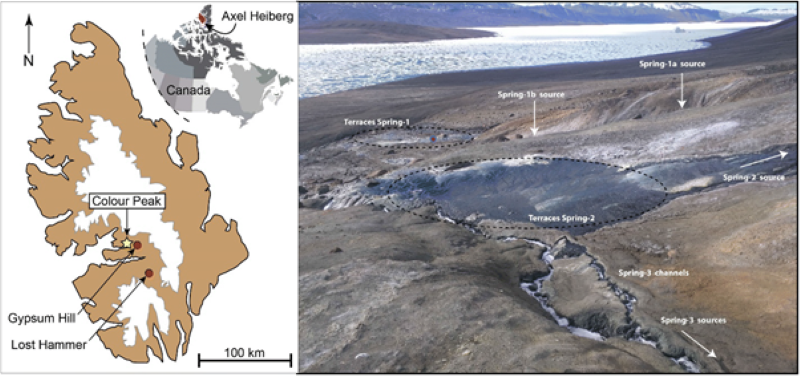 (A) Map of Axel Heiberg Island (brown), and icecaps (white) produced by modifying an image from Google Maps (Map Data @2020 Google) using Illustrator Creative Cloud version 21.0.2. (B) Photographs of the CP springs and precipitates along a CP spring channel with annotated spring and channel systems. Reproduced from Macey et al., 2020 under creative commons license 4.0.
(A) Map of Axel Heiberg Island (brown), and icecaps (white) produced by modifying an image from Google Maps (Map Data @2020 Google) using Illustrator Creative Cloud version 21.0.2. (B) Photographs of the CP springs and precipitates along a CP spring channel with annotated spring and channel systems. Reproduced from Macey et al., 2020 under creative commons license 4.0.
And what about the other part of your work – the simulation experiments?
Modelling and simulation experiments allow us to get even closer to Martian environments. But simulations are still artificial to a greater or lesser degree. For example, at the moment we culture the microorganisms in batches, which wouldn’t happen in the real world. However, we also perform simulations with a continuous culture set up that uses flowing water to replenish nutrients and remove waste materials, cells, and so on. This is much closer to what we observe in lake systems in nature.
We use a range of media that are each suitable for slightly different microbes, working towards isolating interesting microbes into a pure culture so we can assess how they grow. There is inevitably a bias in what we choose to cultivate – we can’t culture everything – but this makes it difficult to assess the profile of an entire microbial community. For example, we wanted to extract DNA from the samples Mark brought back from Colour Peak, to look at the whole microbial community, but the salinity and sulfidic nature of the Colour Peak waters affected the effectiveness of the extraction – something weird happened with the chemistry in combination with the low biomass of the microbes in the samples.
To improve things, we’re developing novel techniques to improve the efficiency of our DNA extraction. We’re washing the salt out of the sediments using lots of water and then filtering the water to collect as many cells as possible. We’re also using very harsh chemicals to burst open the cells to extract their DNA.
We’ve also been able to extract RNA from the Colour Peak samples. This is excellent, as RNA gives us a more accurate view of the living Colour Peak microbial community. The problem is that the coldness and salinity of the Colour Peak water preserves DNA, possibly for millennia. This means the DNA genetic profile includes living microbes, long-dead microbes and no-longer-abundant microbes. But all living cells produce a base level of RNA so by looking at this, we’re able to tell which cells were more recently alive.
Would this apply on Mars – could looking for DNA help you identify life that might have existed there in the past, or looking for RNA help identify more recent life?
Possibly – if life on Mars has a common origin with life on Earth, and if the possible life on Mars was present in the more recent history (somewhere around a million years ago). If there had ever been life on Mars, it could persist, perhaps below the surface, shielded from radiation. When Mars was more Earth-like, with standing bodies of water, could that water have sheltered life? It’s not there now but that’s where its biosignatures would be. Personally, I think anything we detect on Mars will be residual. It’s a question of how intact it is. DNA is stable, but it degrades at a fairly constant rate; the degradation is quicker if conditions are less than optimal, which conditions on Mars definitely are! If we assume a common origin, RNA would only be present if there were genuinely viable microbes there. It’s probably more reliable to look for lipids or other biomarkers, such as pigments, that might be better preserved. These compounds have incredibly long lives; we’ve seen them in samples from the Arctic, from saline lakes in Ethiopia and from studies of estuary waters.
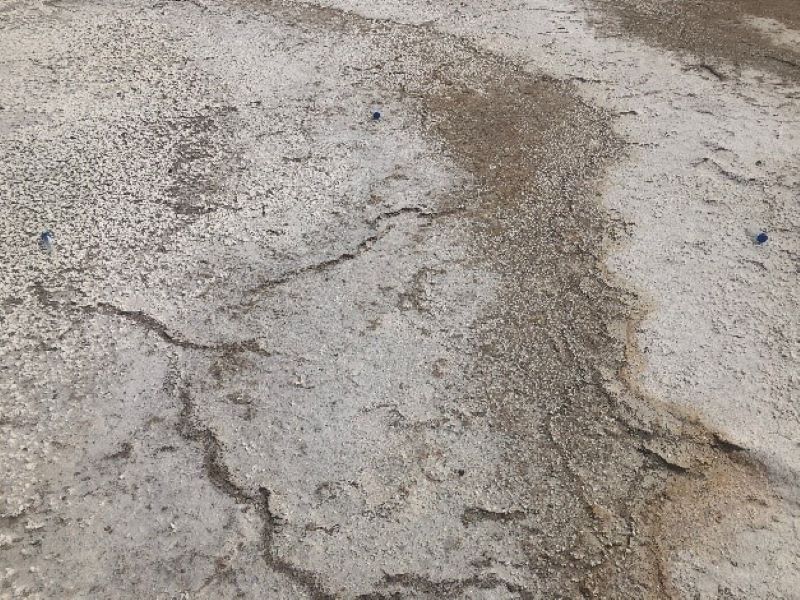 Close-up of one of the salt flats of Kachchh. The location of the plastic tubes shows where we took different samples, capturing some of the visible variation in the salt. We took samples in triplicate from three different points of each site, as replication is important for developing an accurate understanding of the resident microbial community.
Close-up of one of the salt flats of Kachchh. The location of the plastic tubes shows where we took different samples, capturing some of the visible variation in the salt. We took samples in triplicate from three different points of each site, as replication is important for developing an accurate understanding of the resident microbial community.
Have the microbial communities you’ve studied from Earth sites given you any surprises?
In the Colour Peak samples, we isolated a lot more heterotrophic bacteria than we expected. (A heterotroph is an organism that cannot produce its own food but must instead consume other organisms.) The Colour Peak sediments are relatively poor in carbon, so heterotrophy didn’t seem like a successful strategy, and this was an unexpected diversity.
There are similar persistent pockets of diversity in our simulation experiments. We have seen the sulfur-oxidising bacteria that gain their energy by metabolising sulfur and get their carbon by fixing carbon dioxide, but we have also seen microbes that get energy from organic carbon. This suggests that the microbial communities co-exist in a degree of syntrophy – a way of life in which one species lives off the metabolic products of another species.
This is interesting from an ecological perspective, because it suggests sulfur-cycling bacteria are acting as a keystone species, potentially fuelling the carbon cycle. In terms of habitability and viability of environments on Mars, it suggests that they could be context-dependent; a species of microbe may only be viable in the context of a specific community. There is an interplay between a microbe and its environment. Some microbes have been shown not to be cultivatable on their own; they need the presence of another organism. This is known from conservation studies – if you grow two species together, they can grow better, or a species cannot grow on its own. We mustn’t simply consider the viability of an organism on its own but in its context.
This shows the importance of staying open-minded if you’re trying to translate potential biosignatures you’ve identified on Earth into something you could look for on Mars. For example, one way that microbes survive is through necrophagy; in other words, dead organisms are consumed by other members of the community. This could mean that possible biosignatures produced by an organism might be broken down and consumed by other organisms, removing them from an environment.
Finally, what’s the next step for your research?
Potentially, we have drawn all the conclusions we can from broad scale experiments. We are moving on to long-term, continuous cultivation experiments with the Colour Peak samples. Cultivating them under controlled, simulated Martian conditions, we’ll be able to see how the microbial community evolves. We have signs that sulfur-oxidising bacteria can live in this environment and the unexpected heterotrophic diversity we found suggests the sulfur-oxidising bacteria might be supporting other community members. But we really don’t know the direction of the support – are the sulfur-oxidisers supporting the heterotrophs or is it the other way round? Our continuous cultivation experiments will mean we can better establish the relationships and interactions between the different groups in the community.
 This article is part of the Astrobiology Collection on OpenLearn. This collection of free articles, interactives, videos and courses provides insights into research that investigates the possibilities of life beyond the Earth and the ethical and governance implications of this.
This article is part of the Astrobiology Collection on OpenLearn. This collection of free articles, interactives, videos and courses provides insights into research that investigates the possibilities of life beyond the Earth and the ethical and governance implications of this.
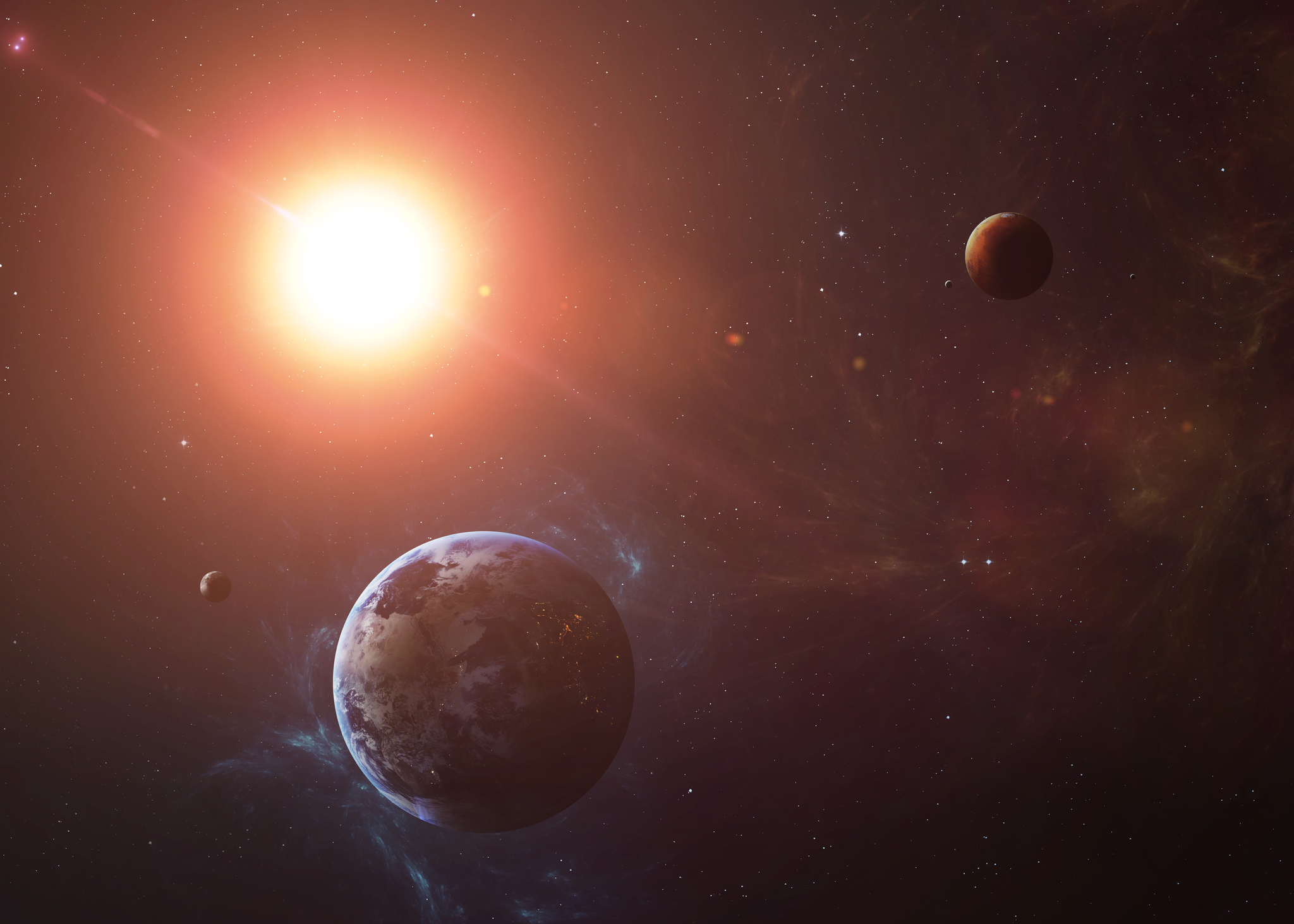
Rate and Review
Rate this article
Review this article
Log into OpenLearn to leave reviews and join in the conversation.
Article reviews